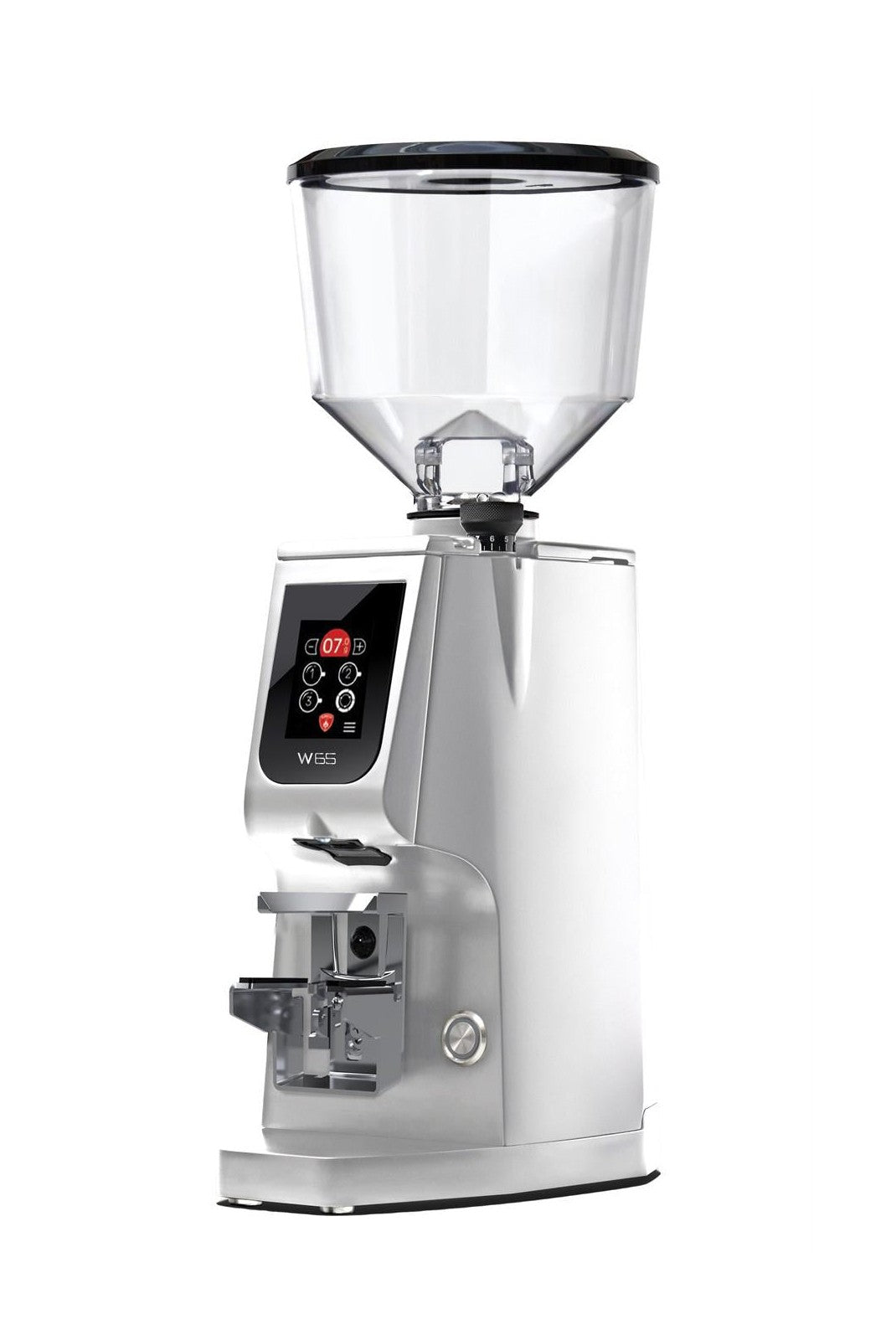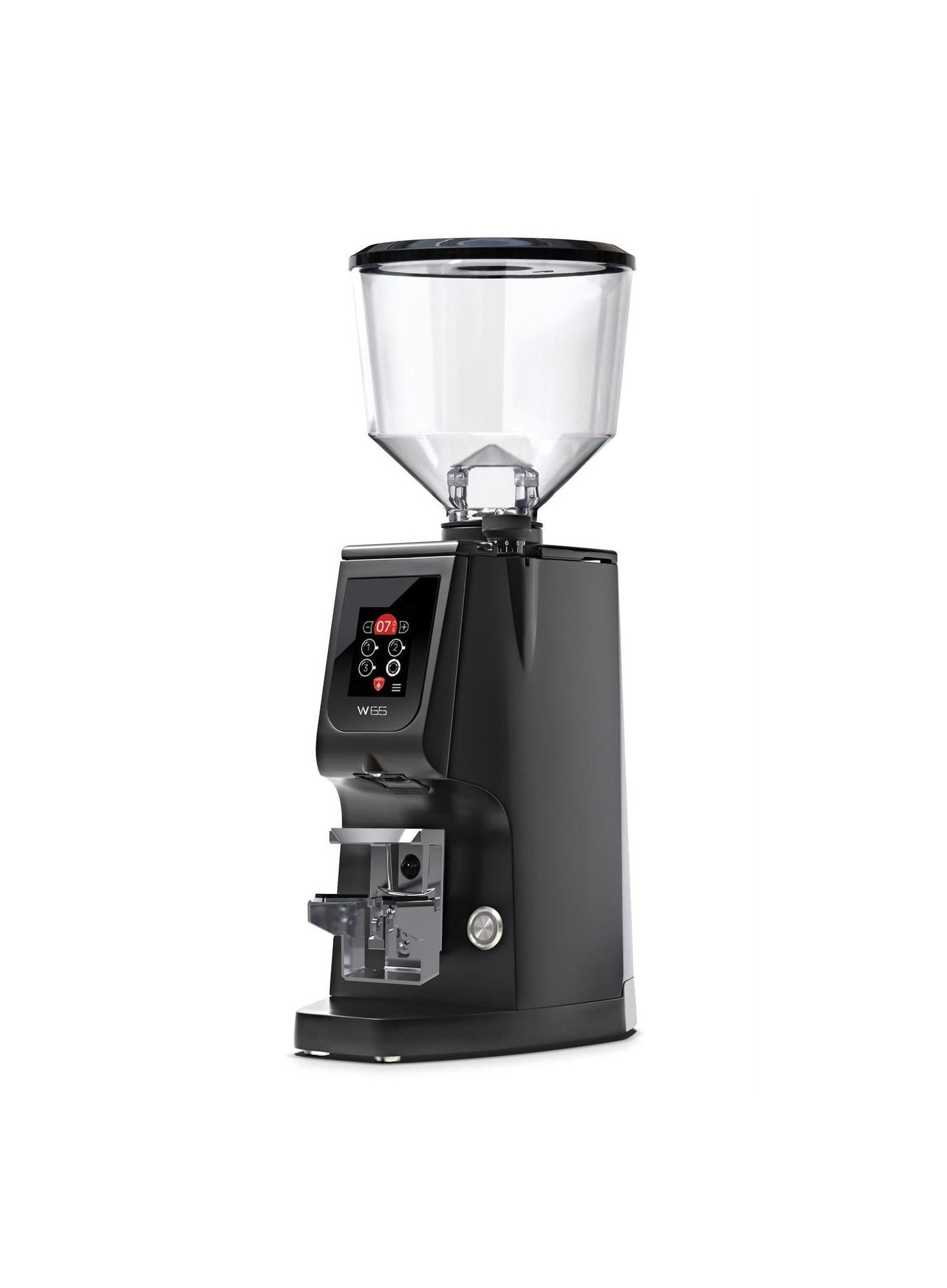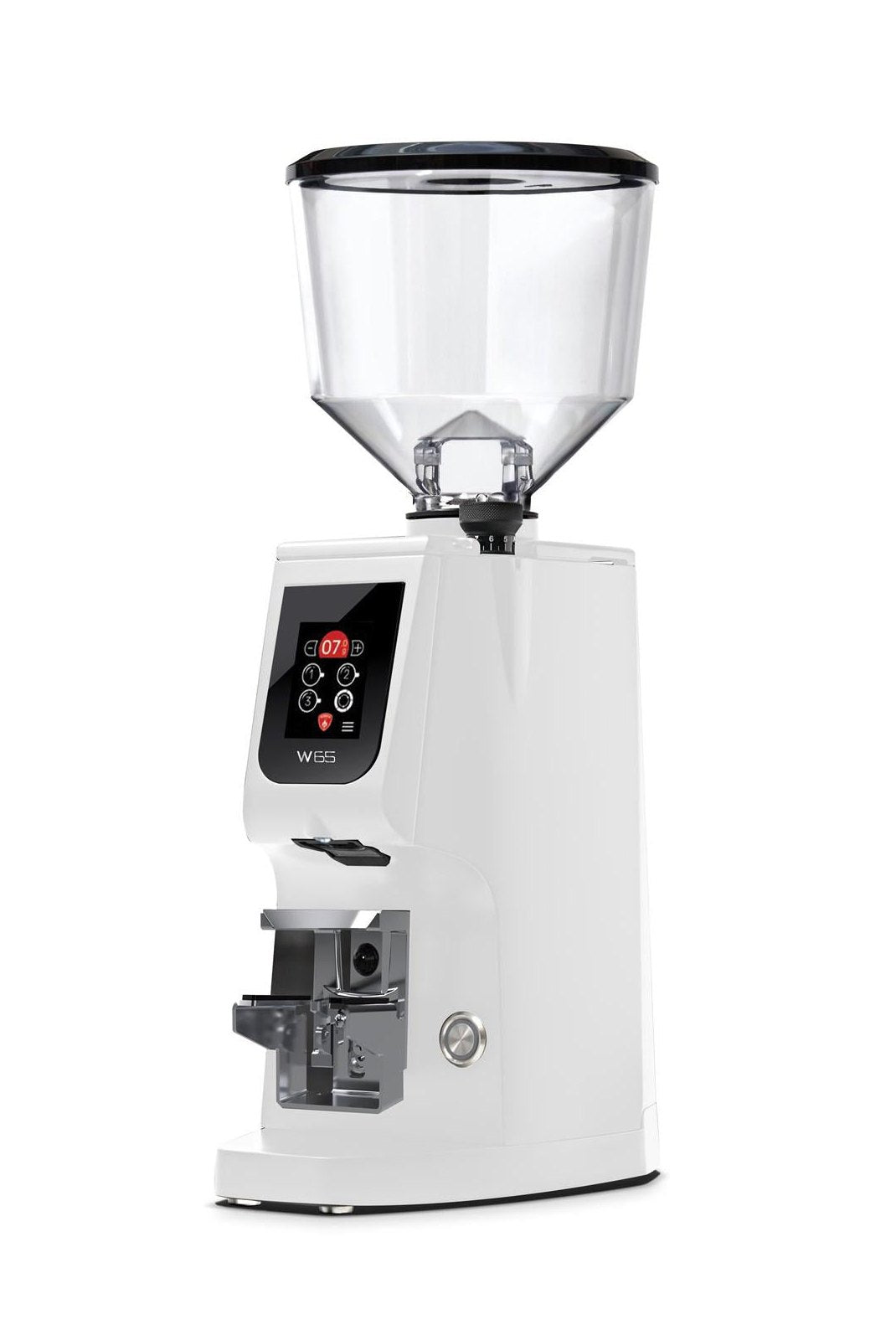


Eureka Atom W 65
inkl. Mehrwertsteuer
Finanzieren ab 70,00 € / Monat* mit
🚚 Náklady na doručenie v EÚ: 34 €
Náklady na doručenie v EÚ, pozri zásady doručenia.
Passt wunderbar dazu

Eureka Atom W 65
Eureka Atom W - presnosť a výkon s technológiou mletia podľa hmotnosti
Eureka Atom W je profesionálny mlynček na espresso s inovatívnou technológiou Grind-by-Weight (GBW). Tá umožňuje riadiť proces mletia presne podľa hmotnosti namiesto času. Vďaka vysokokvalitným mlecím diskom z tvrdenej ocele, technológii Silent Technology na tiché mletie a intuitívnemu dotykovému displeju IPS nastavuje Atom W nové štandardy v oblasti mletia kávy.
Prečo práve Eureka Atom W?
- Technológia mletia podľa hmotnosti - melie presne podľa hmotnosti pre maximálnu konzistenciu
- Technológia okamžitého váženia mletej kávy - váži v reálnom čase počas procesu mletia
- Mlynské kotúče s priemerom 65 mm alebo 75 mm vyrobené z tvrdenej ocele pre vysoký výkon mletia
- Tichá technológia - mimoriadne tichý hluk pri mletí
- Plynulé mikrometrické nastavenie mletia pre maximálnu kontrolu
- Výškovo nastaviteľná vidlica na portafilter "Hands-Free" na jednoduchú manipuláciu
- Intuitívny dotykový displej IPS s 3 programovateľnými dávkami
- Systém ACE na zabránenie zhlukovaniu a elektrostatickému nabíjaniu
- Vysoká rýchlosť mletia - 2-3,5 g/s pre espresso
Presnosť pre domácich baristov a profesionálov
Kávovar Eureka Atom W bol vyvinutý pre milovníkov kávy, ktorí si cenia absolútnu konzistenciu a presnosť. Vďaka stupnici v reálnom čase nie je potrebné opätovne nastavovať čas mletia - požadované množstvo kávy sa dávkuje s presnosťou na desatiny gramu. Takže môžete zakaždým presne reprodukovať svoj dokonalý recept.
Technické vlastnosti
- Typ stroja: mlynček na mletie na požiadanie s integrovanou stupnicou
- Mlecie kotúče: 65 mm alebo 75 mm z tvrdenej ocele
- Kapacita nádoby na zrná: 1,2 kg
- Rýchlosť mletia: 2-3,5 g/s pre espresso
- Príkon: 280 W
- Počet otáčok: 1 370 ot/min
- Tichá technológia: Áno
- Systém ACE: Áno
- Dotykový displej: technológia IPS
- Rozmery (Š x H x V): 18 x 24 x 43 cm
- Hmotnosť: 11,5 kg
S kávovarom Eureka Atom W získate jeden z najmodernejších mlynčekov na kávu na trhu - ideálny pre náročných domácich baristov a profesionálov, ktorí očakávajú nekompromisnú kvalitu.
Angaben zum Hersteller
* Bonität vorausgesetzt. Ratenbeispiel für PayPal Ratenzahlung: effektiver Jahreszins 12,49 % p.a., fester Sollzinssatz 11,80 % p.a., Laufzeit 24 Monate. Genaue Konditionen und Gesamtkosten werden im nächsten Schritt von PayPal angezeigt. Angebot gültig nur für Kunden mit Wohnsitz in Deutschland. Weitere Infos zur Bonitätsprüfung.
Wenn Sie Fragen haben, können Sie sich jederzeit an uns wenden. Wir werden uns so schnell wie möglich bei Ihnen melden, werktags innerhalb von 24 Stunden.
-
Versandinfo
Wir versenden alle Produkte am selben Tag, bei einer Bestellung bis 13.00 Uhr.
-
Support
Auch nach deinem Kauf stehen wir dir beiseite und beraten dich. Hast du Fragen zu dem bei uns gekauften Produkt, dann kontaktiere uns bitte.
-
Kontakt
Email: hello@naturbohne.de
Telefon: 07454 / 870 48 64
Häufige Fragen
Ich habe eine neue Kaffeemühle bei Naturbohne gekauft und es befinden sich Kaffeereste darin.
Bitte beachte: Einige Hersteller testen ihre Kaffeemühlen vor dem Versand, wodurch sich gelegentlich kleine Kaffeereste oder Bohnenreste in der Mühle befinden können. Dieses Verfahren dient der Funktionsprüfung und gilt als Qualitätsmerkmal. Selbstverständlich verkaufen wir ausschließlich Neuware – sofern nicht ausdrücklich anders angegeben.
Statische Aufladung – Kaffeemehl spritzt seitlich raus
Bei manchen Kaffeemühlen kann es vorkommen, dass das Kaffeemehl statisch aufgeladen wird und seitlich aus dem Siebträger herausspritzt. Dadurch gelangt nicht das komplette Kaffeemehl in den Siebträger, was zu einer ungleichmäßigen Extraktion führen kann. Unsere Empfehlung: Verwenden Sie einen Dosing Funnel, um sicherzustellen, dass das gesamte Kaffeemehl präzise in den Siebträger geleitet wird – für einen optimalen Espresso-Genuss.
Was ist der Totraum bei Kaffeemühlen?
Bei herkömmlichen Kaffeemühlen verbleibt oft ein sogenannter Totraum, in dem sich Kaffeereste ansammeln. Diese Rückstände können nicht nur die Frische beeinträchtigen, sondern auch dazu führen, dass altes und frisches Kaffeemehl vermischt wird, was den Geschmack negativ beeinflusst. Im Gegensatz dazu verfügen Single Dose Mühlen über ein durchdachtes Design, das den Totraum eliminiert. Jede Portion wird einzeln und präzise gemahlen, sodass keine Reste zurückbleiben – für einen stets reinen und vollmundigen Kaffeegenuss.
Welcher Siebträger passt zu meiner Espressomaschine?
Bei der Wahl des richtigen Siebträgers für Ihre Siebträgermaschine ist es wichtig zu wissen, dass jeder Hersteller seine eigene Brühgruppe entwickelt – die wohl bekannteste ist die Faema E61. Dies bedeutet jedoch nicht, dass jeder beliebige Siebträger ohne Weiteres passt. Ein nicht kompatibler Siebträger kann undicht sein, was sich unmittelbar negativ auf die Qualität Ihres Espressos auswirkt. Daher empfehlen wir, entweder den ursprünglich mitgelieferten Siebträger zu verwenden oder einen, der explizit als kompatibel mit Ihrer Maschine ausgewiesen ist. So stellen Sie sicher, dass der Druck optimal aufgebaut und der Espresso perfekt extrahiert wird.
Kann ich euch auch besuchen oder die Ware persönlich abholen?
Ja klar, nach Vereinbarung kannst du gerne vorbeikommen und unsere Produkte anschauen. Wir beraten dich gerne persönlich. Am besten schickst du uns hierfür eine E-Mail mit ein paar Terminvorschläge.
Wir befinden uns 5min von der Autobahn zwischen Stuttgart und Bodensee am Rande des Schwarzwaldes.
Wichtiger Hinweis, erste Benutzung Kaffeemühlen
Noch ein kleiner Tipp für den perfekten Start mit deiner neuen Mühle:
Das beste Mahlergebnis erzielst du, nachdem du etwa 1-2 kg Bohnen gemahlen hast. Am besten nimmst du dafür ein paar günstige Bohnen, damit sich das Mahlwerk optimal einarbeitet.Und falls du dich fragst, was du mit dem Bohnenmehl machen kannst – perfekter Pflanzendünger! 🌿
Es enthält Stickstoff, Kalium, Schwefel und Phosphor und ist eine echte Nährstoffbombe für deine Pflanzen.
Könnt ihr bei meiner Siebträgermaschine eine Offset Kalibrierung durchführen ?
Es gibt einige Argumente, die gegen eine Offset-Kalibrierung bei Lelit-Siebträgermaschinen sprechen, insbesondere bei Modellen wie der Lelit Bianca. Diese beziehen sich vor allem auf die Komplexität und die Limitierungen des Offsets als alleinige Lösung für Temperaturprobleme:
- Temperaturschwankungen und Instabilität. Der Offset berücksichtigt eine konstante Differenz zwischen Kesseltemperatur und Brühtemperatur. In der Praxis können jedoch Temperaturschwankungen auftreten, z. B. durch längere Standzeiten oder kontinuierliches Brühen. Dadurch ist die tatsächliche Brühtemperatur nicht immer präzise vorhersehbar.
- Abhängigkeit von Umgebungsbedingungen. Faktoren wie Raumtemperatur, Luftfeuchtigkeit und der Zustand der Maschine (z. B. Aufheizzeit) beeinflussen die Brühtemperatur erheblich. Ein fester Offset kann diese Variablen nicht dynamisch ausgleichen, was zu ungenauen Ergebnissen führen kann.
- Wärmeverlust bei Standzeiten. Nach längeren Pausen kühlt die Brühgruppe ab, und die Maschine benötigt Zeit, um wieder auf die gewünschte Temperatur zu kommen. Ein korrekt eingestellter Offset kann dies nicht kompensieren, weshalb zusätzliche Maßnahmen wie ein “Cooling Flush” nötig sind.
- Fehlkalibrierungen ab Werk. Bei einigen Lelit-Modellen wurde festgestellt, dass der Offset ab Werk oft ungenau eingestellt ist (z. B. 4–8 Grad zu niedrig bei der Lelit Bianca). Dies erfordert eine manuelle Nachkalibrierung durch Fachpersonal, was für Endnutzer kompliziert sein kann.
- Missverständnisse in der Anwendung. Viele Nutzer sind durch widersprüchliche Informationen zur Offset-Einstellung verunsichert, was zu Fehlanpassungen führen kann. Beispielsweise wird oft erwartet, dass der Offset allein alle Temperaturprobleme löst, obwohl er nur ein Teil eines komplexeren Systems ist.
Fazit
Die Offset-Kalibrierung ist ein nützliches Werkzeug, aber sie sollte nicht isoliert betrachtet werden. Eine Kombination aus präziser PID-Steuerung, regelmäßiger Wartung und angepassten Techniken (z. B. Spülshots) ist notwendig, um optimale Brühergebnisse zu erzielen.
Hast du noch Fragen?
Kontakt
Falls du noch Fragen zu unseren Produkten hast, schreib uns gerne hier oder benutze die Chatfunktion.